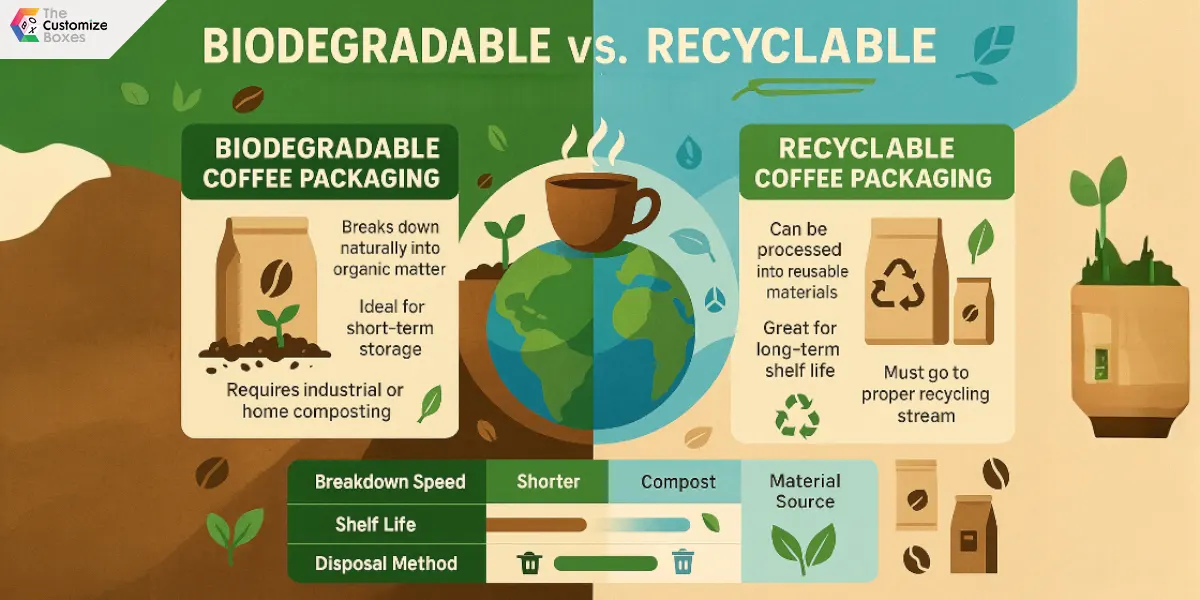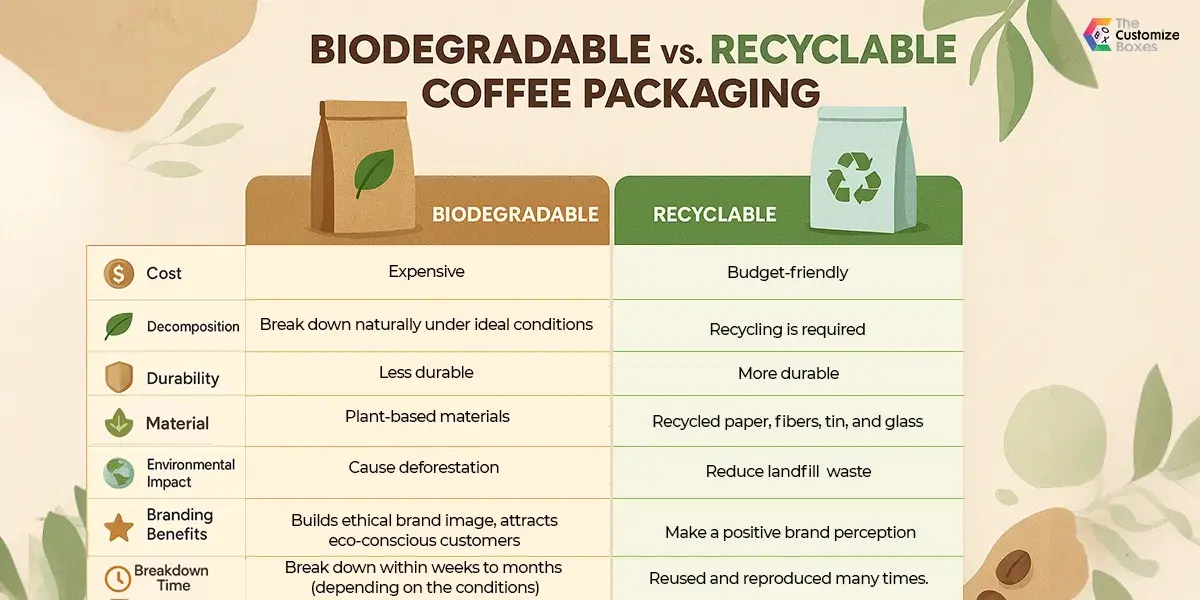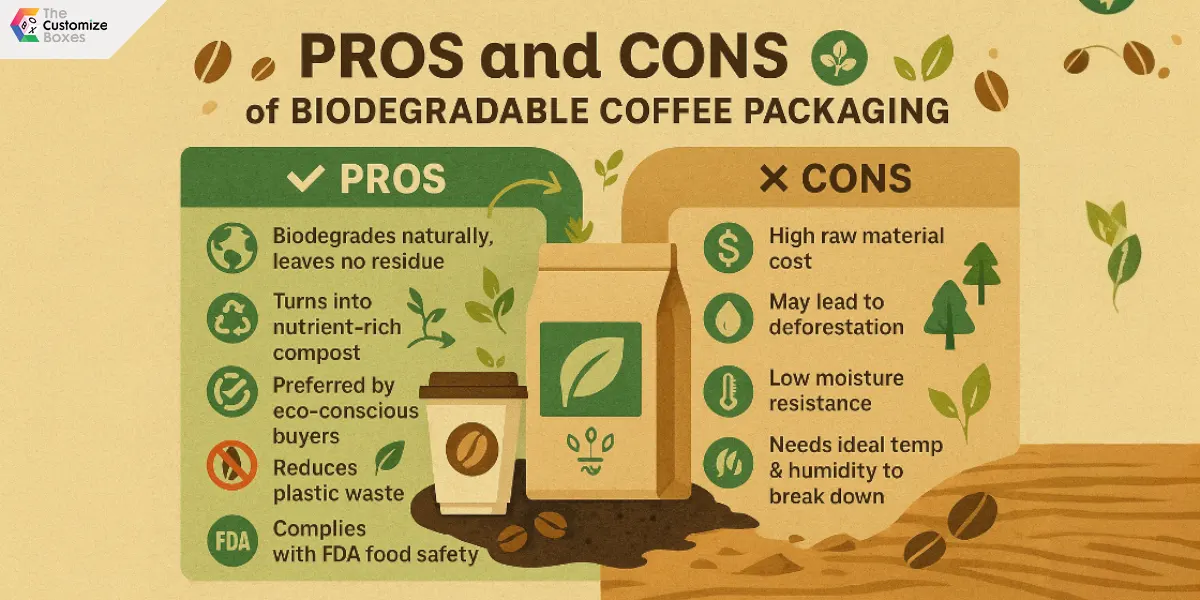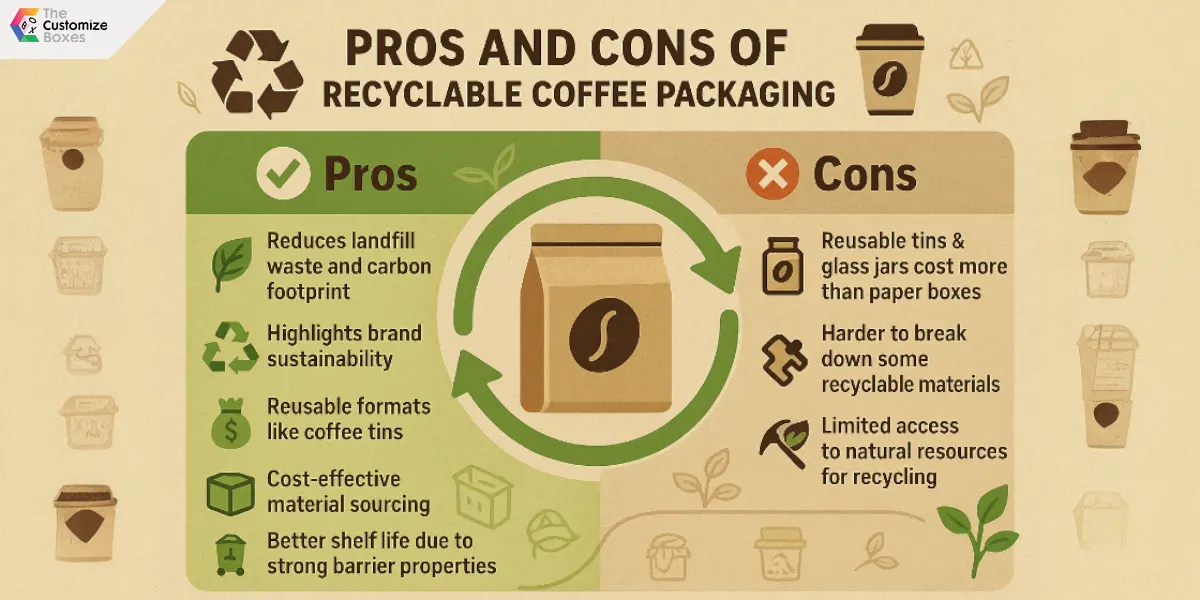
About 75% of Americans consume coffee every day, showing the rising demand for coffee and its packaging. At the same time, consumers prefer buying food items like coffee in sustainable packaging. As the demand for coffee increases, the demand for sustainable coffee packaging increases.
One thing that people often get confused about is biodegradable vs. recyclable coffee packaging. Some people perceive them as the same, but actually, they are not.
Both recyclable and biodegradable coffee packaging are used as an eco-friendly alternative to plastic packaging to ensure environmental sustainability.
Read this blog for a comprehensive review!
What is Biodegradable Coffee Packaging?
Before delving into the details of biodegradable vs. recyclable coffee packaging, understand what biodegradable coffee packaging is. Have you seen coffee packaging on the retail shelves? Can you differentiate whether they are biodegradable or recyclable?
Let’s make it easier for you! Custom kraft boxes in brown color, which you often see on retail shelves, are considered biodegradable coffee packaging because they are made from virgin kraft paper, which is sourced from wood pulp.
In simple words, coffee packaging that biodegrades the way plants do is known as biodegradable packaging. Natural fibers, plant starches, and wood pulp are some popular materials that are used for creating biodegradable packaging for coffee.
What is Recyclable Coffee Packaging?
Recyclable coffee packaging is also eco-friendly. As its name suggests, it can be recycled to create new packaging materials. Paper fibers and post-industrial paper waste can be used to create recycled coffee packaging.
It helps save the environment in many ways, from reducing landfill waste to preventing deforestation. A recent study also shows that 1 ton of paper waste can save 15 to 17 mature trees. So, when analysing biodegradable vs. recyclable coffee packaging, understand how recyclable coffee packaging is made.
It can be customized in different forms, like coffee boxes, bags, and compostable degassing valves that ensure the extended shelf life of your coffee products. Recyclable coffee packaging can be made from recycled tin, paper, aluminium, and glass.
Biodegradable vs. Recyclable Coffee Packaging: Key Difference
Now, let’s delve into the key differences when analysing biodegradable vs. recyclable coffee packaging. The following chart can help you understand the core difference between biodegradable and recyclable coffee packaging:

Pros and Cons of Biodegradable Coffee Packaging

Given the fact that both biodegradable and recyclable coffee packaging can be eco-friendly, they still have some disadvantages. Let’s make the biodegradable vs. recyclable coffee packaging debate easier for you by listing the advantages and disadvantages of both of them, respectively.
Pros of Biodegradable Coffee Packaging
The following are some top benefits of biodegradable coffee packaging everyone should know about:
- Biodegradable coffee packaging biodegrades naturally, leaving no harmful residue.
- The decomposition of biodegradable packaging results in enriched soil conditions.
- Consumers prefer buying biodegradable coffee packaging to reduce landfill waste.
- Biodegradable coffee packaging works as the best alternative to plastic packaging.
- Biodegradable coffee packaging aligns with the FDA’s regulations for food packaging.
Cons of Biodegradable Coffee Packaging
Know the following disadvantages of biodegradable coffee packaging when analysing biodegradable vs. recyclable coffee packaging:
- Expensive raw materials are required for biodegradable packaging.
- Biodegradable packaging affects the environment through deforestation.
- Lower moisture resistance does not ensure the longevity of coffee in biodegradable packaging.
- Ideal temperature and humidity are needed for the decomposition of biodegradable coffee packaging.
Pros and Cons of Recyclable Coffee Packaging

Let’s move to the pros and cons of recyclable coffee packaging to help you choose what aligns with your needs and budget.
Advantages of Recyclable Coffee Packaging
Recyclable coffee packaging has a lot of benefits. Some of them are as follows:
- Reduces landfill waste, carbon footprint, and packaging waste.
- Recyclable packaging portrays your brand’s sustainability values.
- Allows users to reuse recyclable coffee packaging, such as coffee tins.
- Recyclable coffee packaging is pocket-friendly due to lower material costs.
- Recyclable coffee packaging ensures extended shelf life due to great barrier properties.
Disadvantages of Recyclable Coffee Packaging
Have a look at a few disadvantages of recyclable coffee packaging to completely understand biodegradable vs. recyclable coffee packaging:
- Reusable and recyclable tin and glass coffee packaging is more expensive than boxes.
- Some recyclable coffee packaging materials are hard to break down into pieces.
- The limitation of natural resources in recyclable coffee packaging is a challenge no one can ignore.
What to Choose Between Biodegradable and Recyclable Coffee Packaging?
When exploring biodegradable vs. recyclable coffee packaging, you must choose the one that aligns with your budget, packaging needs, customers’ preferences, and brand persona. Now let’s conclude the debate with the fact that both biodegradable and recyclable coffee packaging options are far better than single-use plastic packaging that takes hundreds of years to decompose. Challenges will come with each sustainable packaging option, but all brands need to find a way forward and put their efforts to ensure environmental sustainability!
Some popular coffee packaging options that can biodegrade are as follows:
- Custom kraft coffee boxes
- Bioplastic coffee packaging
- Cellulose fiber coffee packaging
- Seaweed-based coffee packaging
Generally, Kraft coffee packaging biodegrades within a few weeks to a couple of months under ideal conditions. The exact time can vary depending on factors like moisture, temperature, and the presence of microorganisms.
Recyclable coffee packaging comes with the following advantages:
- Prevent pollution
- Conserves resources
- Prevent deforestation
- Reduces landfill waste
- Attract eco-conscious customers
